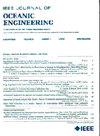A Physics-Based Inversion of Multibeam Sonar Data for Seafloor Characterization
IF 3.8
2区 工程技术
Q1 ENGINEERING, CIVIL
引用次数: 0
Abstract
A physics-based algorithm has been developed for the inversion of multibeam sonar survey data for sediment properties. The algorithm relies on high-frequency acoustical models of seafloor scattering to estimate sediment properties, taking as input the calibrated backscatter intensity time series data for multiple incidence angles. The inversion proceeds in three stages to produce estimates for a suite of geoacoustic and physical parameters of the seafloor, which include sediment attenuation and strengths of interface and volume scattering in the first stage, surface roughness and reflectivity in the second stage, and porosity, density, and sound-speed ratios and mean grain size in the third and final stage. The algorithm uses a Monte-Carlo approach to determine the uncertainties in inversion-derived sediment properties based on the measured statistics of seafloor backscatter. This assessment also takes into account the uncertainties associated with the empirical relations utilized in the final stage of inversion to determine sediment properties from reflectivity. The performance and accuracy of the algorithm have been evaluated through implementation in the processing of field data recorded from Sequim Bay, WA, USA, in 2019. Comparison of inversion output with ground-truth measurements demonstrates the effectiveness and robustness of the algorithm in seafloor characterization with multibeam sonars.基于物理的多波束声纳数据海底特征反演
提出了一种基于物理的多波束声纳测量数据泥沙性质反演算法。该算法以校正后的多入射角后向散射强度时间序列数据为输入,依靠海底散射高频声学模型估计沉积物性质。反演分三个阶段进行,对海底的一套地球声学和物理参数进行估计,其中包括第一阶段的沉积物衰减和界面和体积散射强度,第二阶段的表面粗糙度和反射率,以及第三阶段和最后阶段的孔隙度、密度、声速比和平均粒度。该算法采用蒙特卡罗方法,根据海底后向散射的实测统计量来确定反演沉积物性质的不确定性。该评估还考虑了与反演最后阶段利用经验关系来确定反射率沉积物性质相关的不确定性。通过对2019年美国华盛顿州Sequim Bay现场数据的处理,对该算法的性能和准确性进行了评估。将反演结果与实测结果进行对比,验证了该算法在多波束声纳海底特征描述中的有效性和鲁棒性。
本文章由计算机程序翻译,如有差异,请以英文原文为准。
求助全文
约1分钟内获得全文
求助全文
来源期刊

IEEE Journal of Oceanic Engineering
工程技术-工程:大洋
CiteScore
9.60
自引率
12.20%
发文量
86
审稿时长
12 months
期刊介绍:
The IEEE Journal of Oceanic Engineering (ISSN 0364-9059) is the online-only quarterly publication of the IEEE Oceanic Engineering Society (IEEE OES). The scope of the Journal is the field of interest of the IEEE OES, which encompasses all aspects of science, engineering, and technology that address research, development, and operations pertaining to all bodies of water. This includes the creation of new capabilities and technologies from concept design through prototypes, testing, and operational systems to sense, explore, understand, develop, use, and responsibly manage natural resources.
 求助内容:
求助内容: 应助结果提醒方式:
应助结果提醒方式:


